Supply Chain Management and Logistics
VerifiedAdded on 2022/11/29
|16
|4036
|358
AI Summary
This report examines the CSR metric of Subway and summarizes the buying behavior segments of the products offered by the company. It also discusses the decision factors, product selection, CSR issues, and new metric evaluation.
Contribute Materials
Your contribution can guide someone’s learning journey. Share your
documents today.
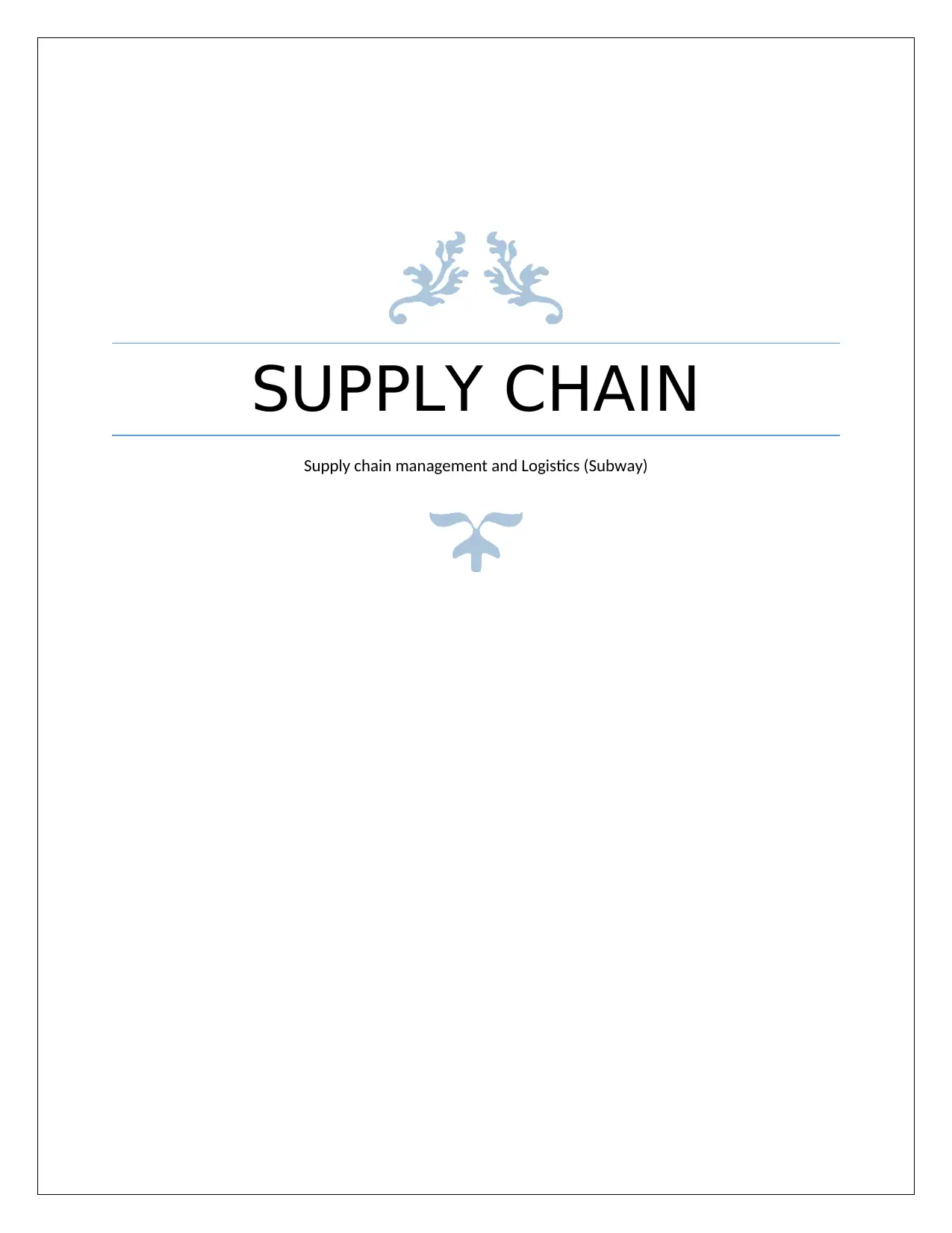
SUPPLY CHAIN
Supply chain management and Logistics (Subway)
Supply chain management and Logistics (Subway)
Secure Best Marks with AI Grader
Need help grading? Try our AI Grader for instant feedback on your assignments.
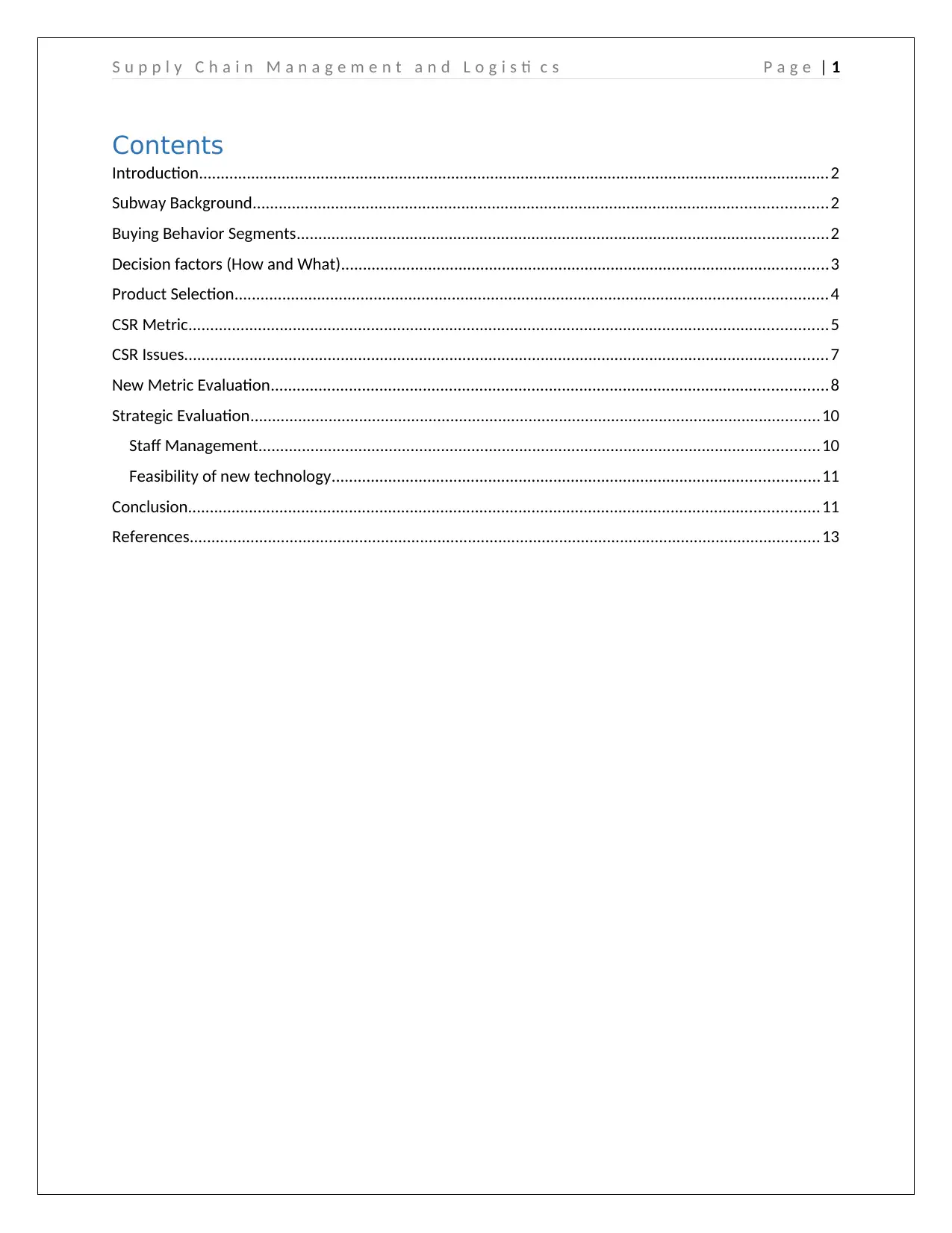
S u p p l y C h a i n M a n a g e m e n t a n d L o g i s ti c s P a g e | 1
Contents
Introduction.................................................................................................................................................2
Subway Background....................................................................................................................................2
Buying Behavior Segments..........................................................................................................................2
Decision factors (How and What)................................................................................................................3
Product Selection........................................................................................................................................4
CSR Metric...................................................................................................................................................5
CSR Issues....................................................................................................................................................7
New Metric Evaluation................................................................................................................................8
Strategic Evaluation...................................................................................................................................10
Staff Management.................................................................................................................................10
Feasibility of new technology................................................................................................................11
Conclusion.................................................................................................................................................11
References.................................................................................................................................................13
Contents
Introduction.................................................................................................................................................2
Subway Background....................................................................................................................................2
Buying Behavior Segments..........................................................................................................................2
Decision factors (How and What)................................................................................................................3
Product Selection........................................................................................................................................4
CSR Metric...................................................................................................................................................5
CSR Issues....................................................................................................................................................7
New Metric Evaluation................................................................................................................................8
Strategic Evaluation...................................................................................................................................10
Staff Management.................................................................................................................................10
Feasibility of new technology................................................................................................................11
Conclusion.................................................................................................................................................11
References.................................................................................................................................................13
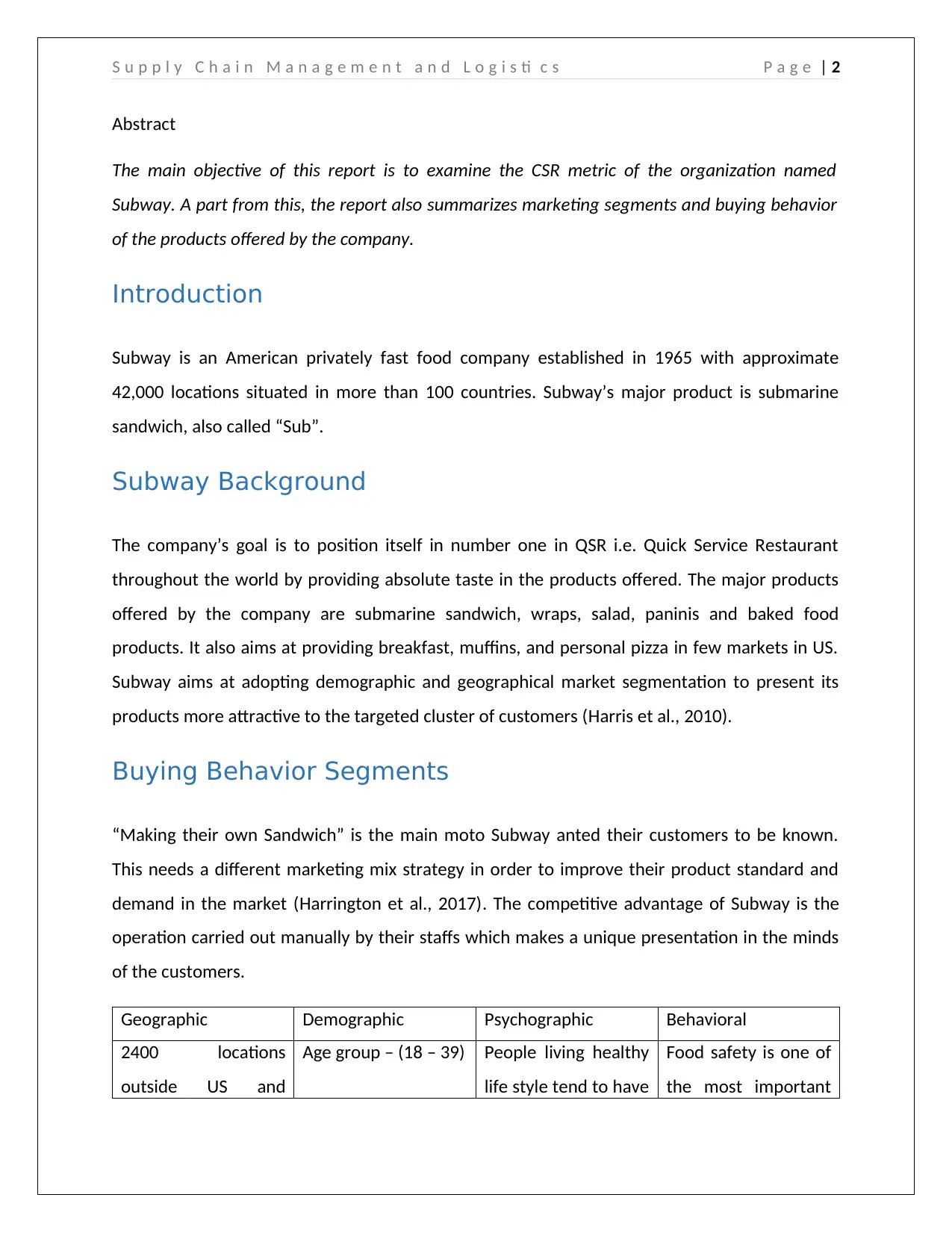
S u p p l y C h a i n M a n a g e m e n t a n d L o g i s ti c s P a g e | 2
Abstract
The main objective of this report is to examine the CSR metric of the organization named
Subway. A part from this, the report also summarizes marketing segments and buying behavior
of the products offered by the company.
Introduction
Subway is an American privately fast food company established in 1965 with approximate
42,000 locations situated in more than 100 countries. Subway’s major product is submarine
sandwich, also called “Sub”.
Subway Background
The company’s goal is to position itself in number one in QSR i.e. Quick Service Restaurant
throughout the world by providing absolute taste in the products offered. The major products
offered by the company are submarine sandwich, wraps, salad, paninis and baked food
products. It also aims at providing breakfast, muffins, and personal pizza in few markets in US.
Subway aims at adopting demographic and geographical market segmentation to present its
products more attractive to the targeted cluster of customers (Harris et al., 2010).
Buying Behavior Segments
“Making their own Sandwich” is the main moto Subway anted their customers to be known.
This needs a different marketing mix strategy in order to improve their product standard and
demand in the market (Harrington et al., 2017). The competitive advantage of Subway is the
operation carried out manually by their staffs which makes a unique presentation in the minds
of the customers.
Geographic Demographic Psychographic Behavioral
2400 locations
outside US and
Age group – (18 – 39) People living healthy
life style tend to have
Food safety is one of
the most important
Abstract
The main objective of this report is to examine the CSR metric of the organization named
Subway. A part from this, the report also summarizes marketing segments and buying behavior
of the products offered by the company.
Introduction
Subway is an American privately fast food company established in 1965 with approximate
42,000 locations situated in more than 100 countries. Subway’s major product is submarine
sandwich, also called “Sub”.
Subway Background
The company’s goal is to position itself in number one in QSR i.e. Quick Service Restaurant
throughout the world by providing absolute taste in the products offered. The major products
offered by the company are submarine sandwich, wraps, salad, paninis and baked food
products. It also aims at providing breakfast, muffins, and personal pizza in few markets in US.
Subway aims at adopting demographic and geographical market segmentation to present its
products more attractive to the targeted cluster of customers (Harris et al., 2010).
Buying Behavior Segments
“Making their own Sandwich” is the main moto Subway anted their customers to be known.
This needs a different marketing mix strategy in order to improve their product standard and
demand in the market (Harrington et al., 2017). The competitive advantage of Subway is the
operation carried out manually by their staffs which makes a unique presentation in the minds
of the customers.
Geographic Demographic Psychographic Behavioral
2400 locations
outside US and
Age group – (18 – 39) People living healthy
life style tend to have
Food safety is one of
the most important
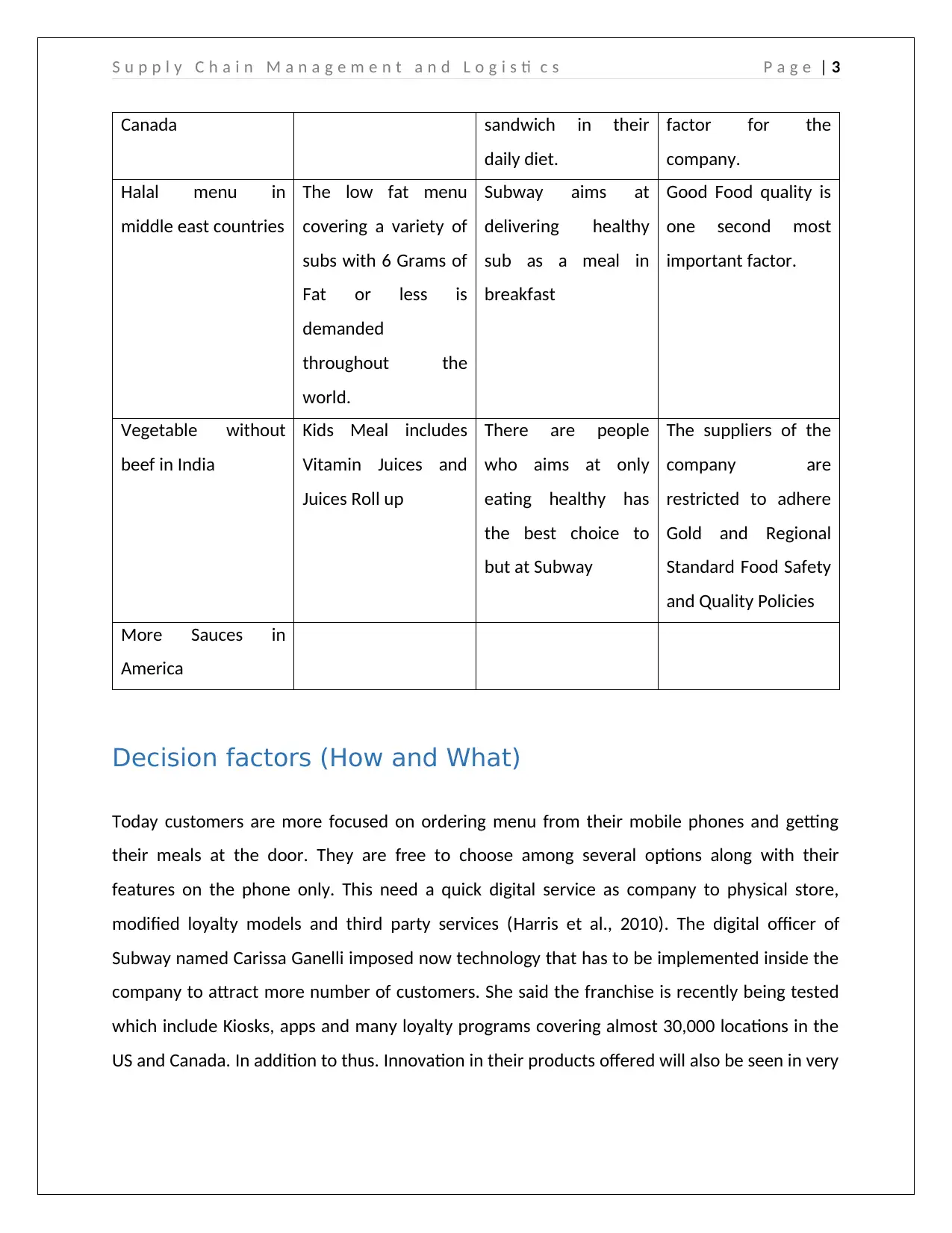
S u p p l y C h a i n M a n a g e m e n t a n d L o g i s ti c s P a g e | 3
Canada sandwich in their
daily diet.
factor for the
company.
Halal menu in
middle east countries
The low fat menu
covering a variety of
subs with 6 Grams of
Fat or less is
demanded
throughout the
world.
Subway aims at
delivering healthy
sub as a meal in
breakfast
Good Food quality is
one second most
important factor.
Vegetable without
beef in India
Kids Meal includes
Vitamin Juices and
Juices Roll up
There are people
who aims at only
eating healthy has
the best choice to
but at Subway
The suppliers of the
company are
restricted to adhere
Gold and Regional
Standard Food Safety
and Quality Policies
More Sauces in
America
Decision factors (How and What)
Today customers are more focused on ordering menu from their mobile phones and getting
their meals at the door. They are free to choose among several options along with their
features on the phone only. This need a quick digital service as company to physical store,
modified loyalty models and third party services (Harris et al., 2010). The digital officer of
Subway named Carissa Ganelli imposed now technology that has to be implemented inside the
company to attract more number of customers. She said the franchise is recently being tested
which include Kiosks, apps and many loyalty programs covering almost 30,000 locations in the
US and Canada. In addition to thus. Innovation in their products offered will also be seen in very
Canada sandwich in their
daily diet.
factor for the
company.
Halal menu in
middle east countries
The low fat menu
covering a variety of
subs with 6 Grams of
Fat or less is
demanded
throughout the
world.
Subway aims at
delivering healthy
sub as a meal in
breakfast
Good Food quality is
one second most
important factor.
Vegetable without
beef in India
Kids Meal includes
Vitamin Juices and
Juices Roll up
There are people
who aims at only
eating healthy has
the best choice to
but at Subway
The suppliers of the
company are
restricted to adhere
Gold and Regional
Standard Food Safety
and Quality Policies
More Sauces in
America
Decision factors (How and What)
Today customers are more focused on ordering menu from their mobile phones and getting
their meals at the door. They are free to choose among several options along with their
features on the phone only. This need a quick digital service as company to physical store,
modified loyalty models and third party services (Harris et al., 2010). The digital officer of
Subway named Carissa Ganelli imposed now technology that has to be implemented inside the
company to attract more number of customers. She said the franchise is recently being tested
which include Kiosks, apps and many loyalty programs covering almost 30,000 locations in the
US and Canada. In addition to thus. Innovation in their products offered will also be seen in very
Secure Best Marks with AI Grader
Need help grading? Try our AI Grader for instant feedback on your assignments.
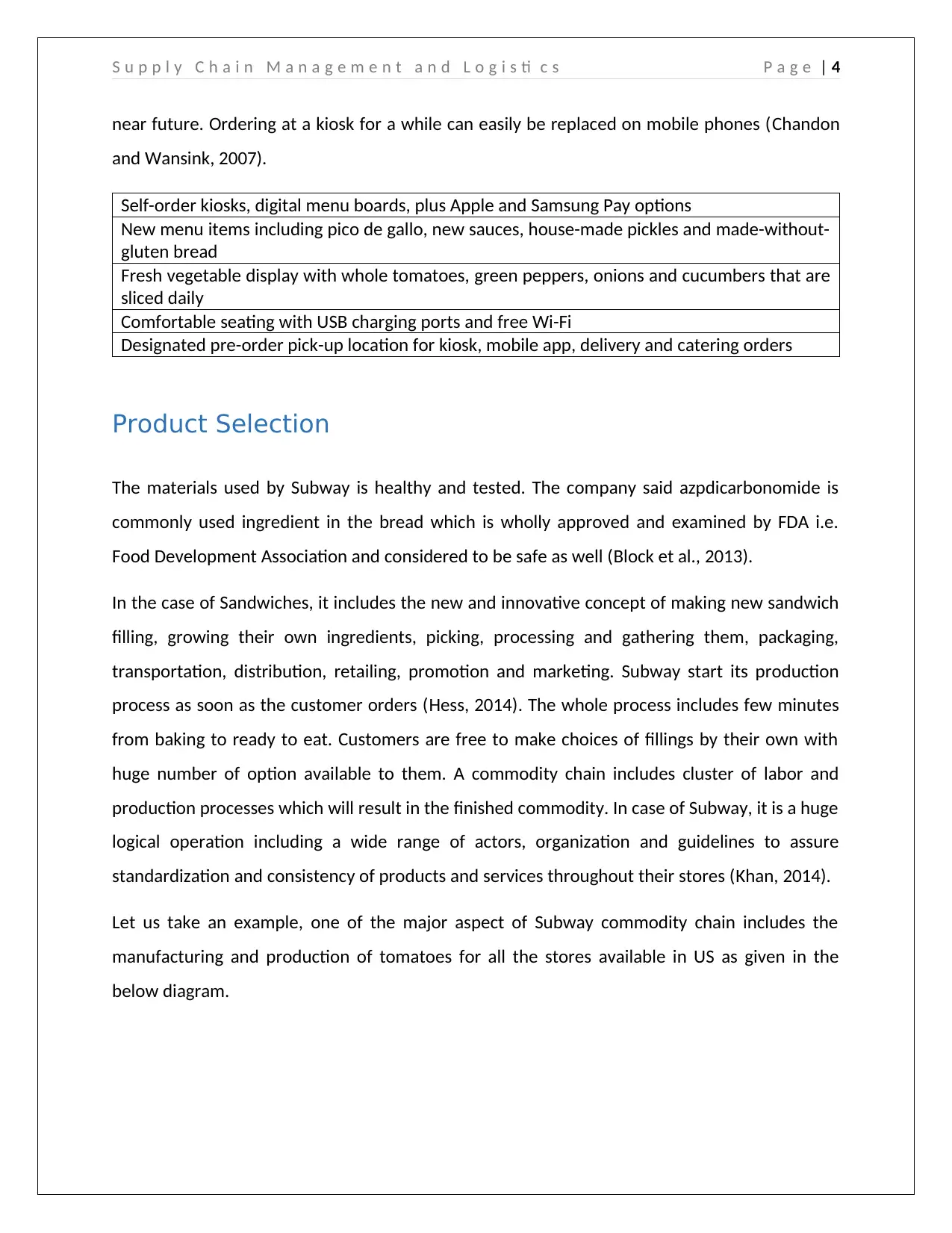
S u p p l y C h a i n M a n a g e m e n t a n d L o g i s ti c s P a g e | 4
near future. Ordering at a kiosk for a while can easily be replaced on mobile phones (Chandon
and Wansink, 2007).
Self-order kiosks, digital menu boards, plus Apple and Samsung Pay options
New menu items including pico de gallo, new sauces, house-made pickles and made-without-
gluten bread
Fresh vegetable display with whole tomatoes, green peppers, onions and cucumbers that are
sliced daily
Comfortable seating with USB charging ports and free Wi-Fi
Designated pre-order pick-up location for kiosk, mobile app, delivery and catering orders
Product Selection
The materials used by Subway is healthy and tested. The company said azpdicarbonomide is
commonly used ingredient in the bread which is wholly approved and examined by FDA i.e.
Food Development Association and considered to be safe as well (Block et al., 2013).
In the case of Sandwiches, it includes the new and innovative concept of making new sandwich
filling, growing their own ingredients, picking, processing and gathering them, packaging,
transportation, distribution, retailing, promotion and marketing. Subway start its production
process as soon as the customer orders (Hess, 2014). The whole process includes few minutes
from baking to ready to eat. Customers are free to make choices of fillings by their own with
huge number of option available to them. A commodity chain includes cluster of labor and
production processes which will result in the finished commodity. In case of Subway, it is a huge
logical operation including a wide range of actors, organization and guidelines to assure
standardization and consistency of products and services throughout their stores (Khan, 2014).
Let us take an example, one of the major aspect of Subway commodity chain includes the
manufacturing and production of tomatoes for all the stores available in US as given in the
below diagram.
near future. Ordering at a kiosk for a while can easily be replaced on mobile phones (Chandon
and Wansink, 2007).
Self-order kiosks, digital menu boards, plus Apple and Samsung Pay options
New menu items including pico de gallo, new sauces, house-made pickles and made-without-
gluten bread
Fresh vegetable display with whole tomatoes, green peppers, onions and cucumbers that are
sliced daily
Comfortable seating with USB charging ports and free Wi-Fi
Designated pre-order pick-up location for kiosk, mobile app, delivery and catering orders
Product Selection
The materials used by Subway is healthy and tested. The company said azpdicarbonomide is
commonly used ingredient in the bread which is wholly approved and examined by FDA i.e.
Food Development Association and considered to be safe as well (Block et al., 2013).
In the case of Sandwiches, it includes the new and innovative concept of making new sandwich
filling, growing their own ingredients, picking, processing and gathering them, packaging,
transportation, distribution, retailing, promotion and marketing. Subway start its production
process as soon as the customer orders (Hess, 2014). The whole process includes few minutes
from baking to ready to eat. Customers are free to make choices of fillings by their own with
huge number of option available to them. A commodity chain includes cluster of labor and
production processes which will result in the finished commodity. In case of Subway, it is a huge
logical operation including a wide range of actors, organization and guidelines to assure
standardization and consistency of products and services throughout their stores (Khan, 2014).
Let us take an example, one of the major aspect of Subway commodity chain includes the
manufacturing and production of tomatoes for all the stores available in US as given in the
below diagram.
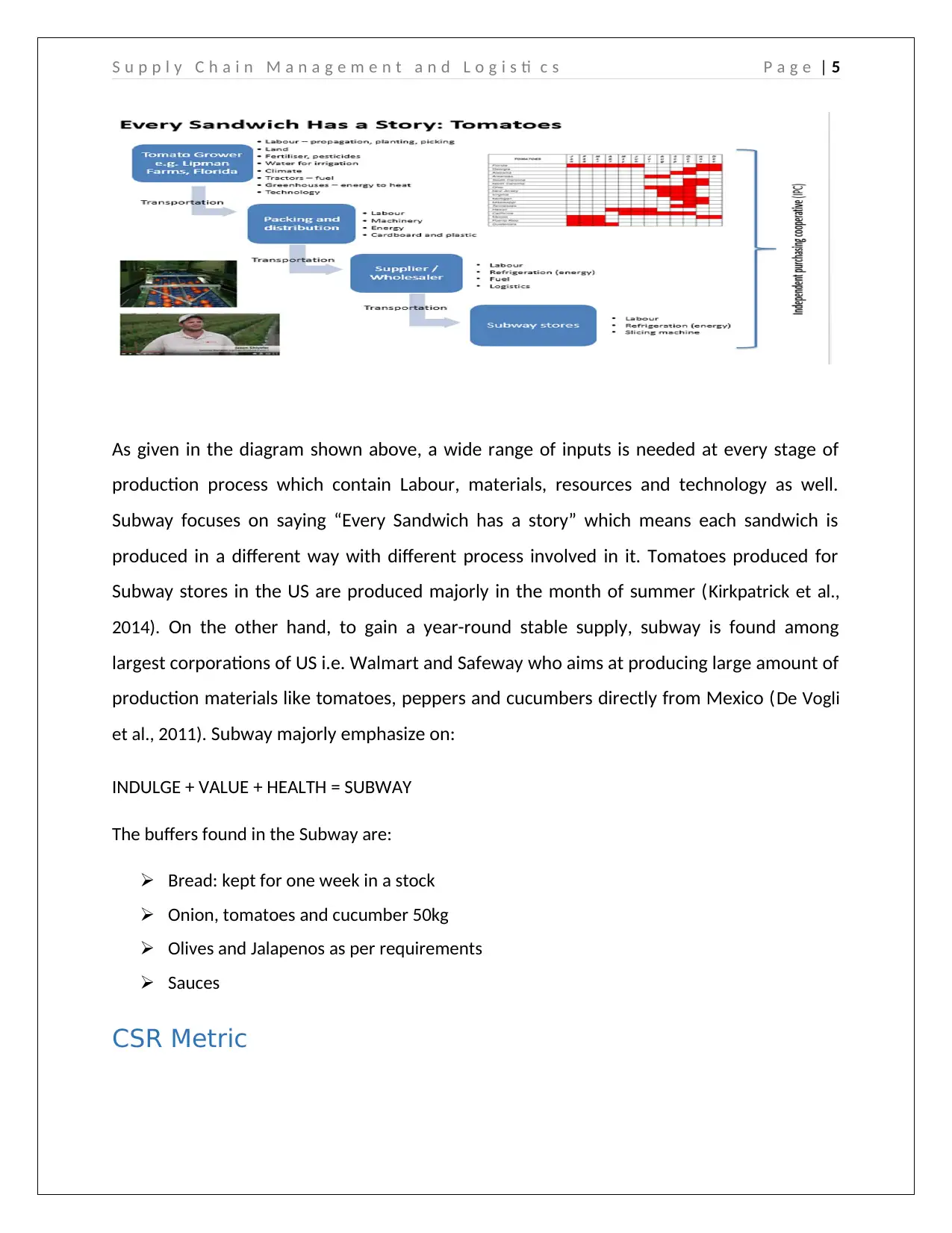
S u p p l y C h a i n M a n a g e m e n t a n d L o g i s ti c s P a g e | 5
As given in the diagram shown above, a wide range of inputs is needed at every stage of
production process which contain Labour, materials, resources and technology as well.
Subway focuses on saying “Every Sandwich has a story” which means each sandwich is
produced in a different way with different process involved in it. Tomatoes produced for
Subway stores in the US are produced majorly in the month of summer (Kirkpatrick et al.,
2014). On the other hand, to gain a year-round stable supply, subway is found among
largest corporations of US i.e. Walmart and Safeway who aims at producing large amount of
production materials like tomatoes, peppers and cucumbers directly from Mexico (De Vogli
et al., 2011). Subway majorly emphasize on:
INDULGE + VALUE + HEALTH = SUBWAY
The buffers found in the Subway are:
Bread: kept for one week in a stock
Onion, tomatoes and cucumber 50kg
Olives and Jalapenos as per requirements
Sauces
CSR Metric
As given in the diagram shown above, a wide range of inputs is needed at every stage of
production process which contain Labour, materials, resources and technology as well.
Subway focuses on saying “Every Sandwich has a story” which means each sandwich is
produced in a different way with different process involved in it. Tomatoes produced for
Subway stores in the US are produced majorly in the month of summer (Kirkpatrick et al.,
2014). On the other hand, to gain a year-round stable supply, subway is found among
largest corporations of US i.e. Walmart and Safeway who aims at producing large amount of
production materials like tomatoes, peppers and cucumbers directly from Mexico (De Vogli
et al., 2011). Subway majorly emphasize on:
INDULGE + VALUE + HEALTH = SUBWAY
The buffers found in the Subway are:
Bread: kept for one week in a stock
Onion, tomatoes and cucumber 50kg
Olives and Jalapenos as per requirements
Sauces
CSR Metric
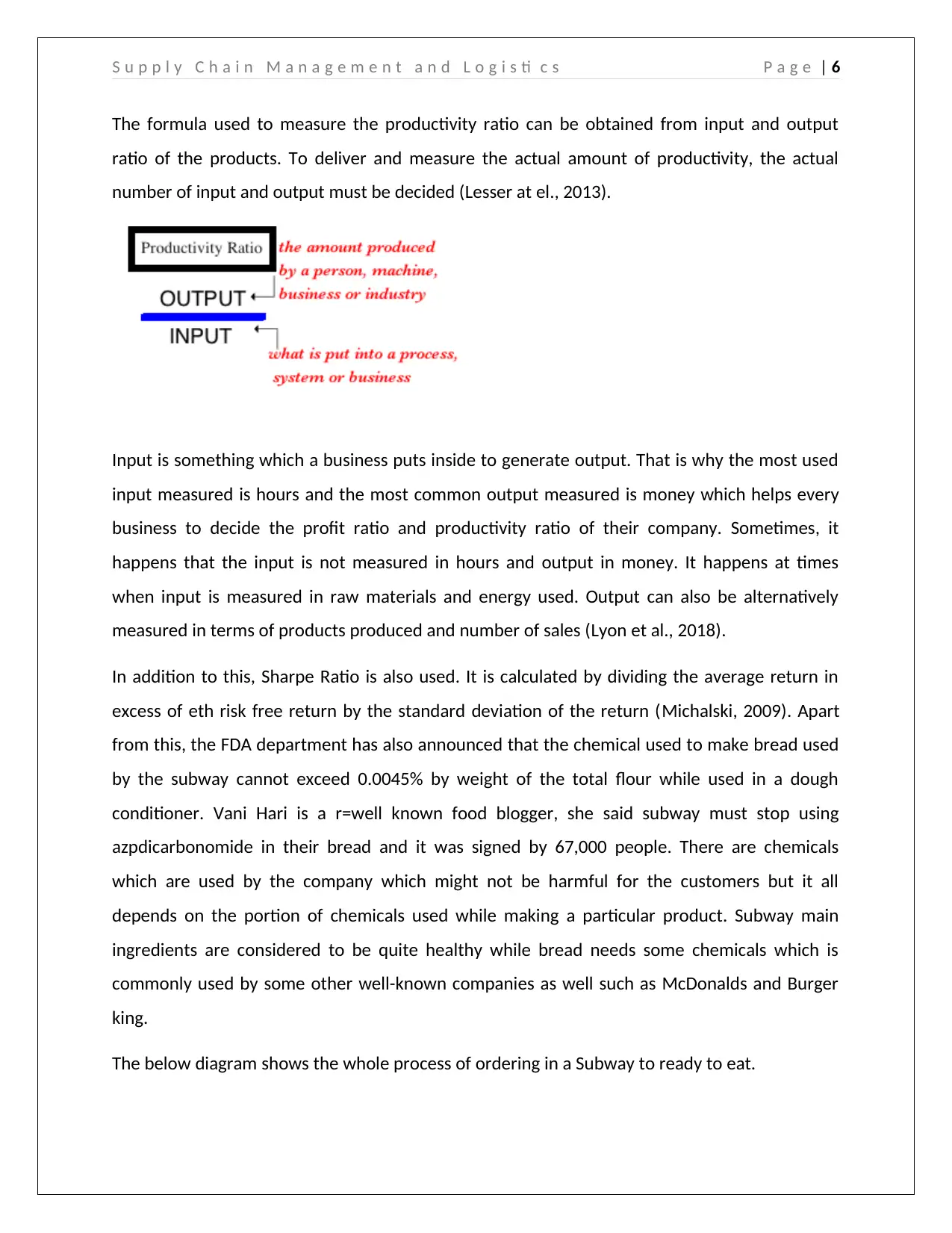
S u p p l y C h a i n M a n a g e m e n t a n d L o g i s ti c s P a g e | 6
The formula used to measure the productivity ratio can be obtained from input and output
ratio of the products. To deliver and measure the actual amount of productivity, the actual
number of input and output must be decided (Lesser at el., 2013).
Input is something which a business puts inside to generate output. That is why the most used
input measured is hours and the most common output measured is money which helps every
business to decide the profit ratio and productivity ratio of their company. Sometimes, it
happens that the input is not measured in hours and output in money. It happens at times
when input is measured in raw materials and energy used. Output can also be alternatively
measured in terms of products produced and number of sales (Lyon et al., 2018).
In addition to this, Sharpe Ratio is also used. It is calculated by dividing the average return in
excess of eth risk free return by the standard deviation of the return (Michalski, 2009). Apart
from this, the FDA department has also announced that the chemical used to make bread used
by the subway cannot exceed 0.0045% by weight of the total flour while used in a dough
conditioner. Vani Hari is a r=well known food blogger, she said subway must stop using
azpdicarbonomide in their bread and it was signed by 67,000 people. There are chemicals
which are used by the company which might not be harmful for the customers but it all
depends on the portion of chemicals used while making a particular product. Subway main
ingredients are considered to be quite healthy while bread needs some chemicals which is
commonly used by some other well-known companies as well such as McDonalds and Burger
king.
The below diagram shows the whole process of ordering in a Subway to ready to eat.
The formula used to measure the productivity ratio can be obtained from input and output
ratio of the products. To deliver and measure the actual amount of productivity, the actual
number of input and output must be decided (Lesser at el., 2013).
Input is something which a business puts inside to generate output. That is why the most used
input measured is hours and the most common output measured is money which helps every
business to decide the profit ratio and productivity ratio of their company. Sometimes, it
happens that the input is not measured in hours and output in money. It happens at times
when input is measured in raw materials and energy used. Output can also be alternatively
measured in terms of products produced and number of sales (Lyon et al., 2018).
In addition to this, Sharpe Ratio is also used. It is calculated by dividing the average return in
excess of eth risk free return by the standard deviation of the return (Michalski, 2009). Apart
from this, the FDA department has also announced that the chemical used to make bread used
by the subway cannot exceed 0.0045% by weight of the total flour while used in a dough
conditioner. Vani Hari is a r=well known food blogger, she said subway must stop using
azpdicarbonomide in their bread and it was signed by 67,000 people. There are chemicals
which are used by the company which might not be harmful for the customers but it all
depends on the portion of chemicals used while making a particular product. Subway main
ingredients are considered to be quite healthy while bread needs some chemicals which is
commonly used by some other well-known companies as well such as McDonalds and Burger
king.
The below diagram shows the whole process of ordering in a Subway to ready to eat.
Paraphrase This Document
Need a fresh take? Get an instant paraphrase of this document with our AI Paraphraser
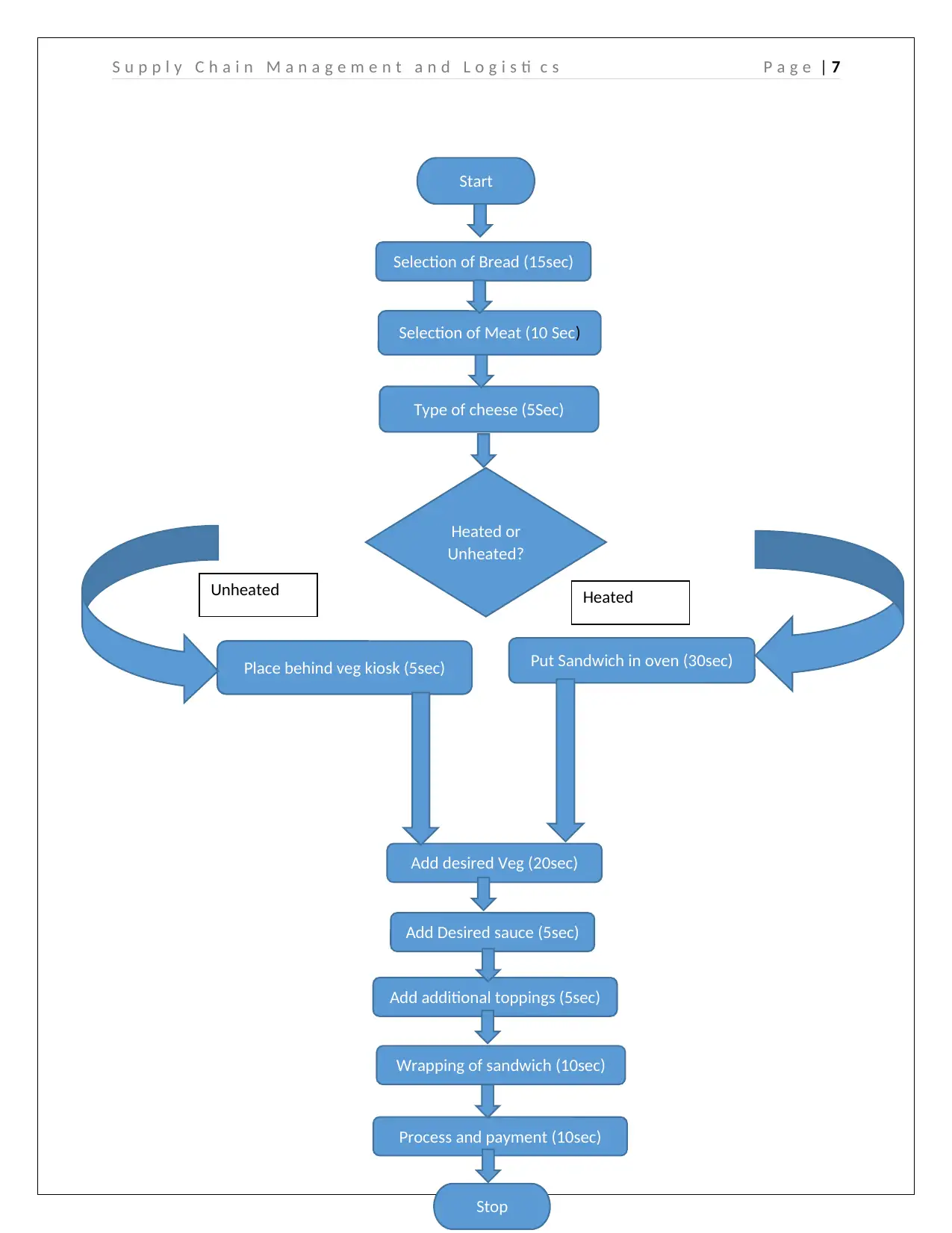
S u p p l y C h a i n M a n a g e m e n t a n d L o g i s ti c s P a g e | 7
Start
Selection of Bread (15sec)
Selection of Meat (10 Sec)
Type of cheese (5Sec)
Place behind veg kiosk (5sec) Put Sandwich in oven (30sec)
Add desired Veg (20sec)
Add Desired sauce (5sec)
Add additional toppings (5sec)
Process and payment (10sec)
Wrapping of sandwich (10sec)
Stop
Heated or
Unheated?
HeatedUnheated
Start
Selection of Bread (15sec)
Selection of Meat (10 Sec)
Type of cheese (5Sec)
Place behind veg kiosk (5sec) Put Sandwich in oven (30sec)
Add desired Veg (20sec)
Add Desired sauce (5sec)
Add additional toppings (5sec)
Process and payment (10sec)
Wrapping of sandwich (10sec)
Stop
Heated or
Unheated?
HeatedUnheated
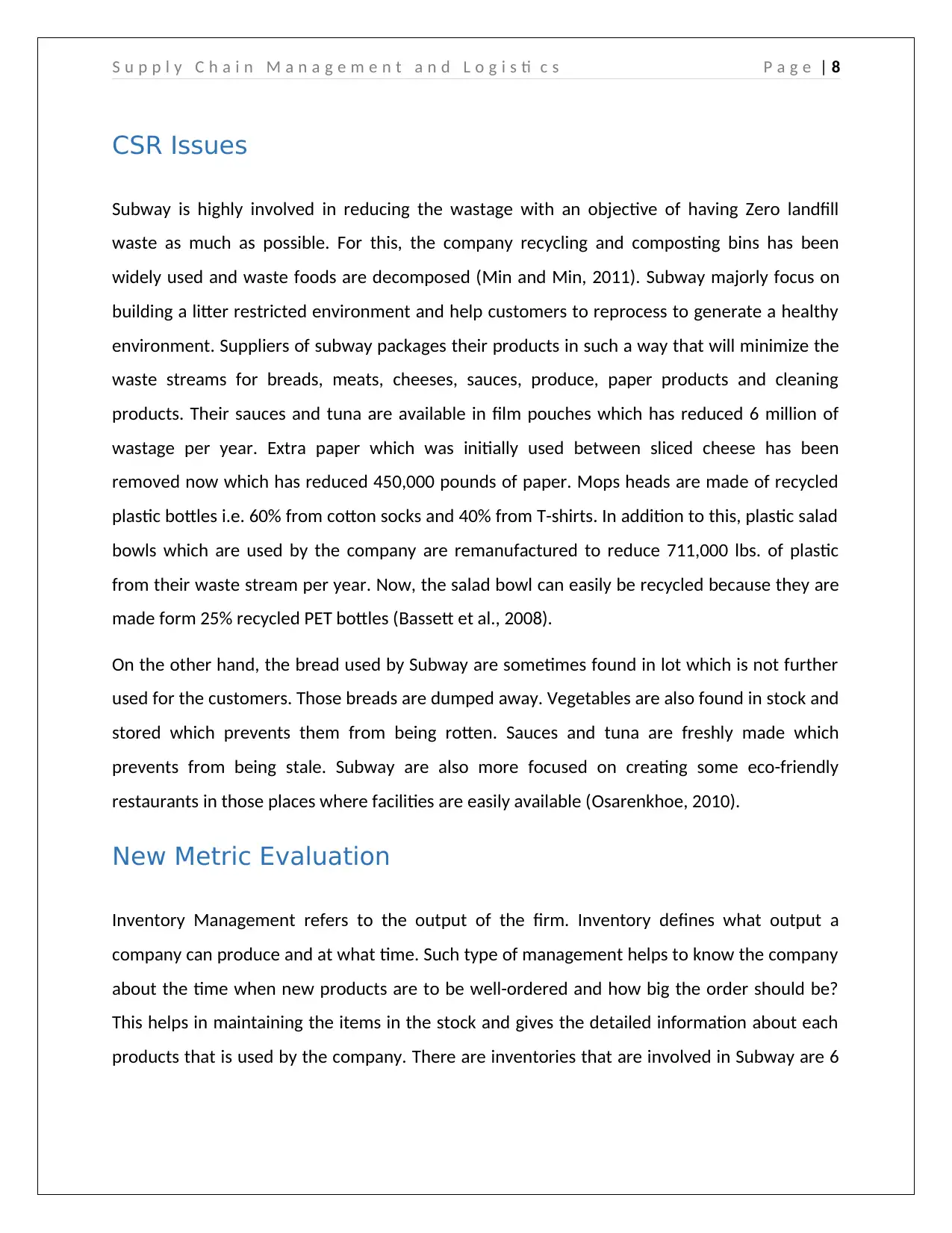
S u p p l y C h a i n M a n a g e m e n t a n d L o g i s ti c s P a g e | 8
CSR Issues
Subway is highly involved in reducing the wastage with an objective of having Zero landfill
waste as much as possible. For this, the company recycling and composting bins has been
widely used and waste foods are decomposed (Min and Min, 2011). Subway majorly focus on
building a litter restricted environment and help customers to reprocess to generate a healthy
environment. Suppliers of subway packages their products in such a way that will minimize the
waste streams for breads, meats, cheeses, sauces, produce, paper products and cleaning
products. Their sauces and tuna are available in film pouches which has reduced 6 million of
wastage per year. Extra paper which was initially used between sliced cheese has been
removed now which has reduced 450,000 pounds of paper. Mops heads are made of recycled
plastic bottles i.e. 60% from cotton socks and 40% from T-shirts. In addition to this, plastic salad
bowls which are used by the company are remanufactured to reduce 711,000 lbs. of plastic
from their waste stream per year. Now, the salad bowl can easily be recycled because they are
made form 25% recycled PET bottles (Bassett et al., 2008).
On the other hand, the bread used by Subway are sometimes found in lot which is not further
used for the customers. Those breads are dumped away. Vegetables are also found in stock and
stored which prevents them from being rotten. Sauces and tuna are freshly made which
prevents from being stale. Subway are also more focused on creating some eco-friendly
restaurants in those places where facilities are easily available (Osarenkhoe, 2010).
New Metric Evaluation
Inventory Management refers to the output of the firm. Inventory defines what output a
company can produce and at what time. Such type of management helps to know the company
about the time when new products are to be well-ordered and how big the order should be?
This helps in maintaining the items in the stock and gives the detailed information about each
products that is used by the company. There are inventories that are involved in Subway are 6
CSR Issues
Subway is highly involved in reducing the wastage with an objective of having Zero landfill
waste as much as possible. For this, the company recycling and composting bins has been
widely used and waste foods are decomposed (Min and Min, 2011). Subway majorly focus on
building a litter restricted environment and help customers to reprocess to generate a healthy
environment. Suppliers of subway packages their products in such a way that will minimize the
waste streams for breads, meats, cheeses, sauces, produce, paper products and cleaning
products. Their sauces and tuna are available in film pouches which has reduced 6 million of
wastage per year. Extra paper which was initially used between sliced cheese has been
removed now which has reduced 450,000 pounds of paper. Mops heads are made of recycled
plastic bottles i.e. 60% from cotton socks and 40% from T-shirts. In addition to this, plastic salad
bowls which are used by the company are remanufactured to reduce 711,000 lbs. of plastic
from their waste stream per year. Now, the salad bowl can easily be recycled because they are
made form 25% recycled PET bottles (Bassett et al., 2008).
On the other hand, the bread used by Subway are sometimes found in lot which is not further
used for the customers. Those breads are dumped away. Vegetables are also found in stock and
stored which prevents them from being rotten. Sauces and tuna are freshly made which
prevents from being stale. Subway are also more focused on creating some eco-friendly
restaurants in those places where facilities are easily available (Osarenkhoe, 2010).
New Metric Evaluation
Inventory Management refers to the output of the firm. Inventory defines what output a
company can produce and at what time. Such type of management helps to know the company
about the time when new products are to be well-ordered and how big the order should be?
This helps in maintaining the items in the stock and gives the detailed information about each
products that is used by the company. There are inventories that are involved in Subway are 6
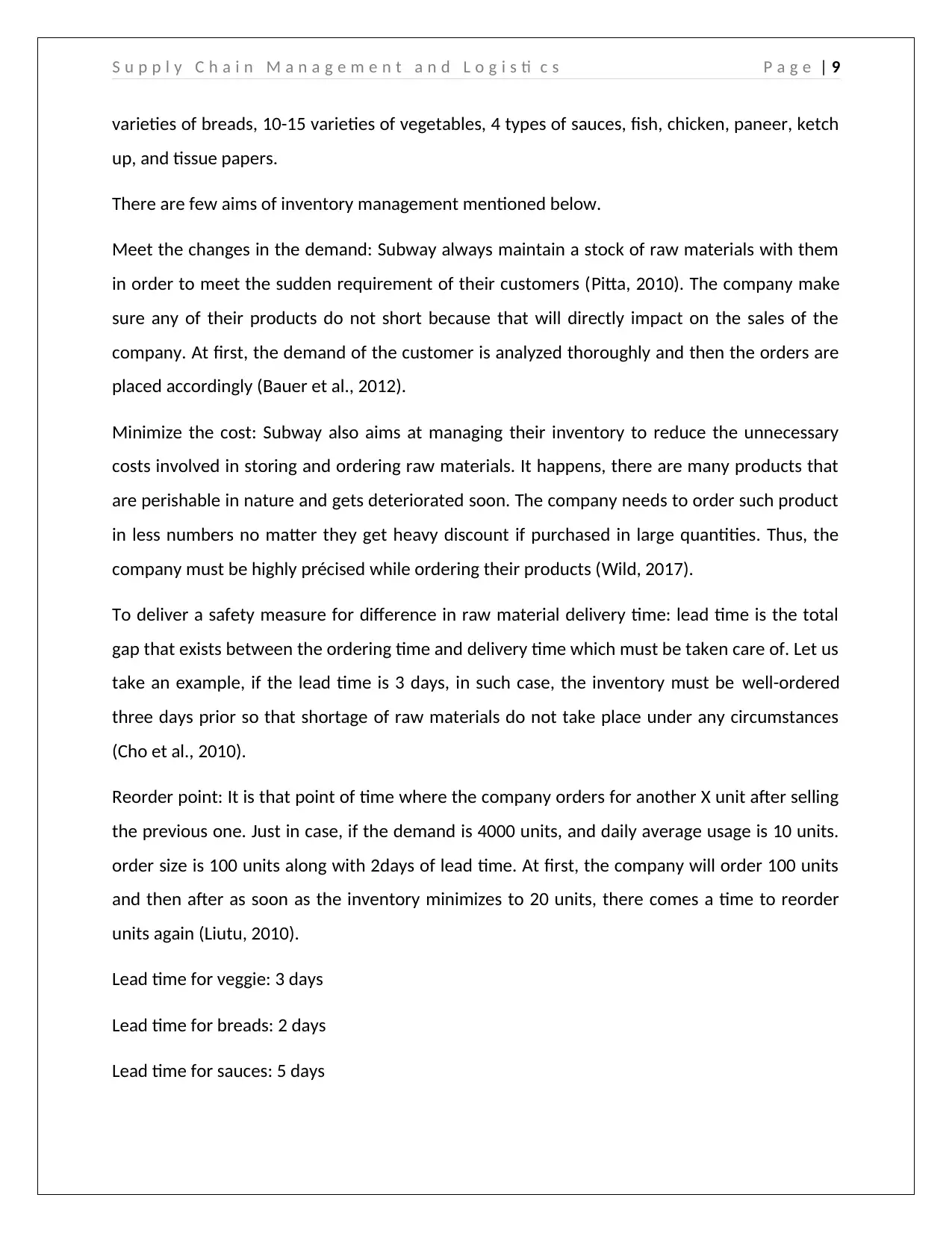
S u p p l y C h a i n M a n a g e m e n t a n d L o g i s ti c s P a g e | 9
varieties of breads, 10-15 varieties of vegetables, 4 types of sauces, fish, chicken, paneer, ketch
up, and tissue papers.
There are few aims of inventory management mentioned below.
Meet the changes in the demand: Subway always maintain a stock of raw materials with them
in order to meet the sudden requirement of their customers (Pitta, 2010). The company make
sure any of their products do not short because that will directly impact on the sales of the
company. At first, the demand of the customer is analyzed thoroughly and then the orders are
placed accordingly (Bauer et al., 2012).
Minimize the cost: Subway also aims at managing their inventory to reduce the unnecessary
costs involved in storing and ordering raw materials. It happens, there are many products that
are perishable in nature and gets deteriorated soon. The company needs to order such product
in less numbers no matter they get heavy discount if purchased in large quantities. Thus, the
company must be highly précised while ordering their products (Wild, 2017).
To deliver a safety measure for difference in raw material delivery time: lead time is the total
gap that exists between the ordering time and delivery time which must be taken care of. Let us
take an example, if the lead time is 3 days, in such case, the inventory must be well-ordered
three days prior so that shortage of raw materials do not take place under any circumstances
(Cho et al., 2010).
Reorder point: It is that point of time where the company orders for another X unit after selling
the previous one. Just in case, if the demand is 4000 units, and daily average usage is 10 units.
order size is 100 units along with 2days of lead time. At first, the company will order 100 units
and then after as soon as the inventory minimizes to 20 units, there comes a time to reorder
units again (Liutu, 2010).
Lead time for veggie: 3 days
Lead time for breads: 2 days
Lead time for sauces: 5 days
varieties of breads, 10-15 varieties of vegetables, 4 types of sauces, fish, chicken, paneer, ketch
up, and tissue papers.
There are few aims of inventory management mentioned below.
Meet the changes in the demand: Subway always maintain a stock of raw materials with them
in order to meet the sudden requirement of their customers (Pitta, 2010). The company make
sure any of their products do not short because that will directly impact on the sales of the
company. At first, the demand of the customer is analyzed thoroughly and then the orders are
placed accordingly (Bauer et al., 2012).
Minimize the cost: Subway also aims at managing their inventory to reduce the unnecessary
costs involved in storing and ordering raw materials. It happens, there are many products that
are perishable in nature and gets deteriorated soon. The company needs to order such product
in less numbers no matter they get heavy discount if purchased in large quantities. Thus, the
company must be highly précised while ordering their products (Wild, 2017).
To deliver a safety measure for difference in raw material delivery time: lead time is the total
gap that exists between the ordering time and delivery time which must be taken care of. Let us
take an example, if the lead time is 3 days, in such case, the inventory must be well-ordered
three days prior so that shortage of raw materials do not take place under any circumstances
(Cho et al., 2010).
Reorder point: It is that point of time where the company orders for another X unit after selling
the previous one. Just in case, if the demand is 4000 units, and daily average usage is 10 units.
order size is 100 units along with 2days of lead time. At first, the company will order 100 units
and then after as soon as the inventory minimizes to 20 units, there comes a time to reorder
units again (Liutu, 2010).
Lead time for veggie: 3 days
Lead time for breads: 2 days
Lead time for sauces: 5 days
Secure Best Marks with AI Grader
Need help grading? Try our AI Grader for instant feedback on your assignments.
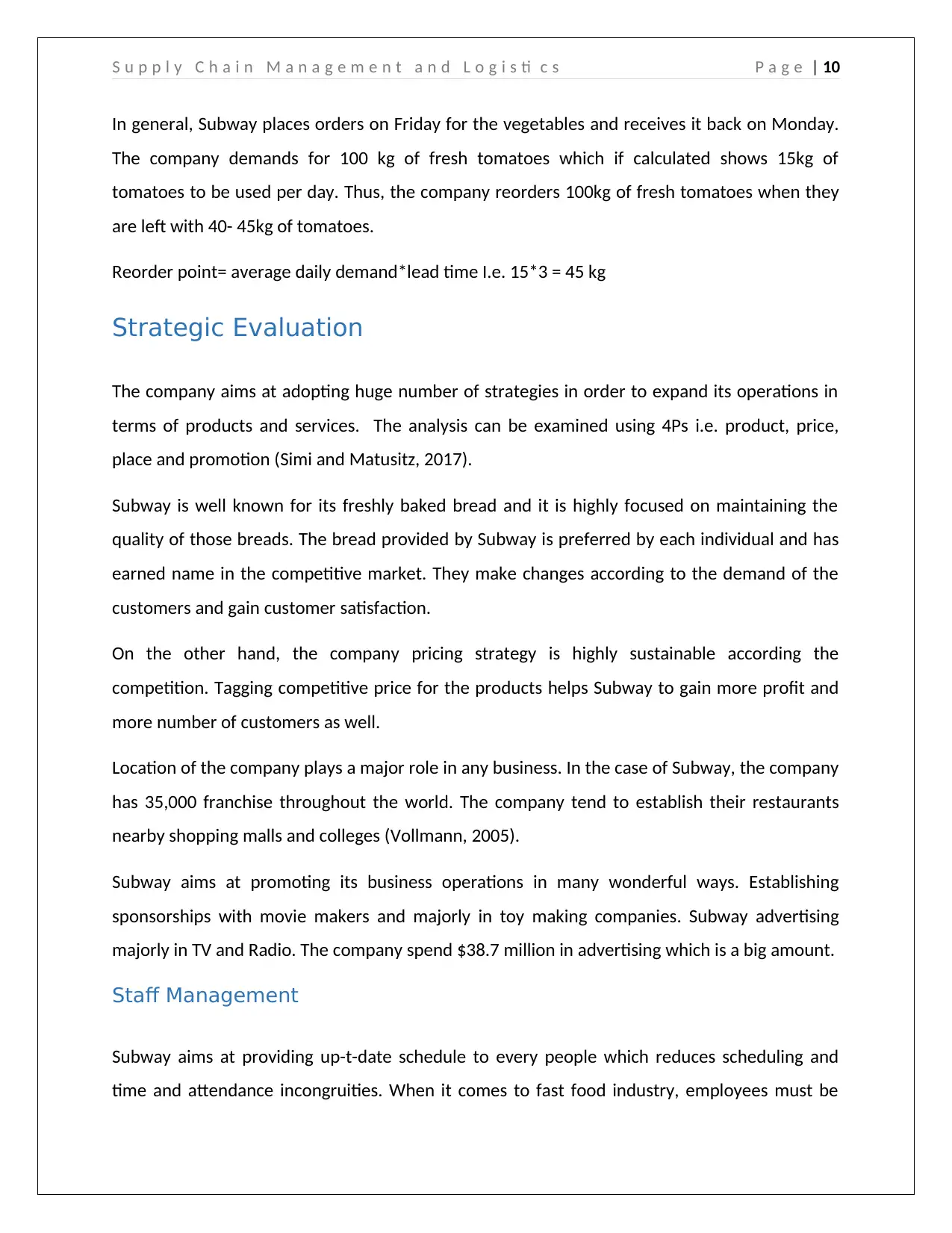
S u p p l y C h a i n M a n a g e m e n t a n d L o g i s ti c s P a g e | 10
In general, Subway places orders on Friday for the vegetables and receives it back on Monday.
The company demands for 100 kg of fresh tomatoes which if calculated shows 15kg of
tomatoes to be used per day. Thus, the company reorders 100kg of fresh tomatoes when they
are left with 40- 45kg of tomatoes.
Reorder point= average daily demand*lead time I.e. 15*3 = 45 kg
Strategic Evaluation
The company aims at adopting huge number of strategies in order to expand its operations in
terms of products and services. The analysis can be examined using 4Ps i.e. product, price,
place and promotion (Simi and Matusitz, 2017).
Subway is well known for its freshly baked bread and it is highly focused on maintaining the
quality of those breads. The bread provided by Subway is preferred by each individual and has
earned name in the competitive market. They make changes according to the demand of the
customers and gain customer satisfaction.
On the other hand, the company pricing strategy is highly sustainable according the
competition. Tagging competitive price for the products helps Subway to gain more profit and
more number of customers as well.
Location of the company plays a major role in any business. In the case of Subway, the company
has 35,000 franchise throughout the world. The company tend to establish their restaurants
nearby shopping malls and colleges (Vollmann, 2005).
Subway aims at promoting its business operations in many wonderful ways. Establishing
sponsorships with movie makers and majorly in toy making companies. Subway advertising
majorly in TV and Radio. The company spend $38.7 million in advertising which is a big amount.
Staff Management
Subway aims at providing up-t-date schedule to every people which reduces scheduling and
time and attendance incongruities. When it comes to fast food industry, employees must be
In general, Subway places orders on Friday for the vegetables and receives it back on Monday.
The company demands for 100 kg of fresh tomatoes which if calculated shows 15kg of
tomatoes to be used per day. Thus, the company reorders 100kg of fresh tomatoes when they
are left with 40- 45kg of tomatoes.
Reorder point= average daily demand*lead time I.e. 15*3 = 45 kg
Strategic Evaluation
The company aims at adopting huge number of strategies in order to expand its operations in
terms of products and services. The analysis can be examined using 4Ps i.e. product, price,
place and promotion (Simi and Matusitz, 2017).
Subway is well known for its freshly baked bread and it is highly focused on maintaining the
quality of those breads. The bread provided by Subway is preferred by each individual and has
earned name in the competitive market. They make changes according to the demand of the
customers and gain customer satisfaction.
On the other hand, the company pricing strategy is highly sustainable according the
competition. Tagging competitive price for the products helps Subway to gain more profit and
more number of customers as well.
Location of the company plays a major role in any business. In the case of Subway, the company
has 35,000 franchise throughout the world. The company tend to establish their restaurants
nearby shopping malls and colleges (Vollmann, 2005).
Subway aims at promoting its business operations in many wonderful ways. Establishing
sponsorships with movie makers and majorly in toy making companies. Subway advertising
majorly in TV and Radio. The company spend $38.7 million in advertising which is a big amount.
Staff Management
Subway aims at providing up-t-date schedule to every people which reduces scheduling and
time and attendance incongruities. When it comes to fast food industry, employees must be
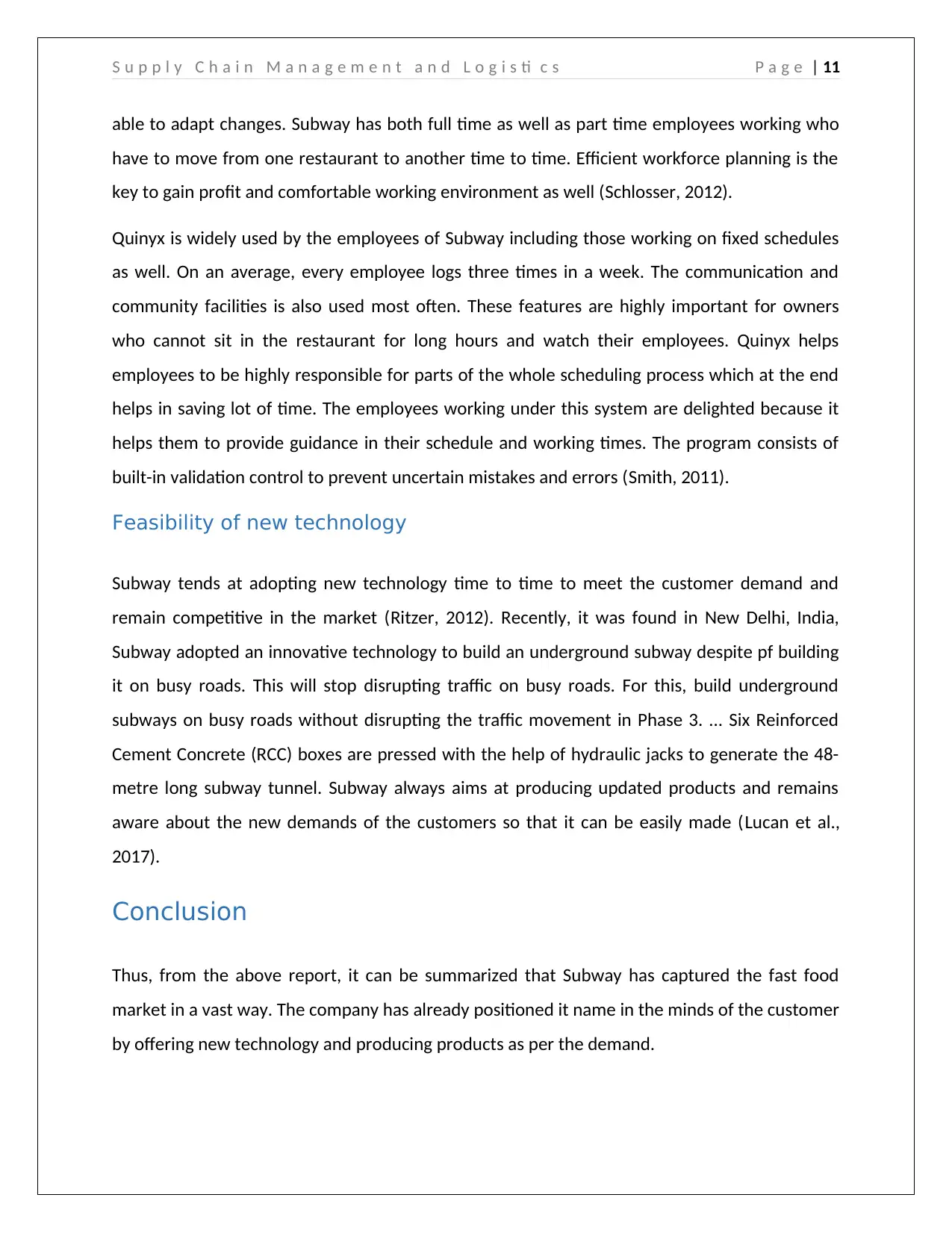
S u p p l y C h a i n M a n a g e m e n t a n d L o g i s ti c s P a g e | 11
able to adapt changes. Subway has both full time as well as part time employees working who
have to move from one restaurant to another time to time. Efficient workforce planning is the
key to gain profit and comfortable working environment as well (Schlosser, 2012).
Quinyx is widely used by the employees of Subway including those working on fixed schedules
as well. On an average, every employee logs three times in a week. The communication and
community facilities is also used most often. These features are highly important for owners
who cannot sit in the restaurant for long hours and watch their employees. Quinyx helps
employees to be highly responsible for parts of the whole scheduling process which at the end
helps in saving lot of time. The employees working under this system are delighted because it
helps them to provide guidance in their schedule and working times. The program consists of
built-in validation control to prevent uncertain mistakes and errors (Smith, 2011).
Feasibility of new technology
Subway tends at adopting new technology time to time to meet the customer demand and
remain competitive in the market (Ritzer, 2012). Recently, it was found in New Delhi, India,
Subway adopted an innovative technology to build an underground subway despite pf building
it on busy roads. This will stop disrupting traffic on busy roads. For this, build underground
subways on busy roads without disrupting the traffic movement in Phase 3. ... Six Reinforced
Cement Concrete (RCC) boxes are pressed with the help of hydraulic jacks to generate the 48-
metre long subway tunnel. Subway always aims at producing updated products and remains
aware about the new demands of the customers so that it can be easily made (Lucan et al.,
2017).
Conclusion
Thus, from the above report, it can be summarized that Subway has captured the fast food
market in a vast way. The company has already positioned it name in the minds of the customer
by offering new technology and producing products as per the demand.
able to adapt changes. Subway has both full time as well as part time employees working who
have to move from one restaurant to another time to time. Efficient workforce planning is the
key to gain profit and comfortable working environment as well (Schlosser, 2012).
Quinyx is widely used by the employees of Subway including those working on fixed schedules
as well. On an average, every employee logs three times in a week. The communication and
community facilities is also used most often. These features are highly important for owners
who cannot sit in the restaurant for long hours and watch their employees. Quinyx helps
employees to be highly responsible for parts of the whole scheduling process which at the end
helps in saving lot of time. The employees working under this system are delighted because it
helps them to provide guidance in their schedule and working times. The program consists of
built-in validation control to prevent uncertain mistakes and errors (Smith, 2011).
Feasibility of new technology
Subway tends at adopting new technology time to time to meet the customer demand and
remain competitive in the market (Ritzer, 2012). Recently, it was found in New Delhi, India,
Subway adopted an innovative technology to build an underground subway despite pf building
it on busy roads. This will stop disrupting traffic on busy roads. For this, build underground
subways on busy roads without disrupting the traffic movement in Phase 3. ... Six Reinforced
Cement Concrete (RCC) boxes are pressed with the help of hydraulic jacks to generate the 48-
metre long subway tunnel. Subway always aims at producing updated products and remains
aware about the new demands of the customers so that it can be easily made (Lucan et al.,
2017).
Conclusion
Thus, from the above report, it can be summarized that Subway has captured the fast food
market in a vast way. The company has already positioned it name in the minds of the customer
by offering new technology and producing products as per the demand.
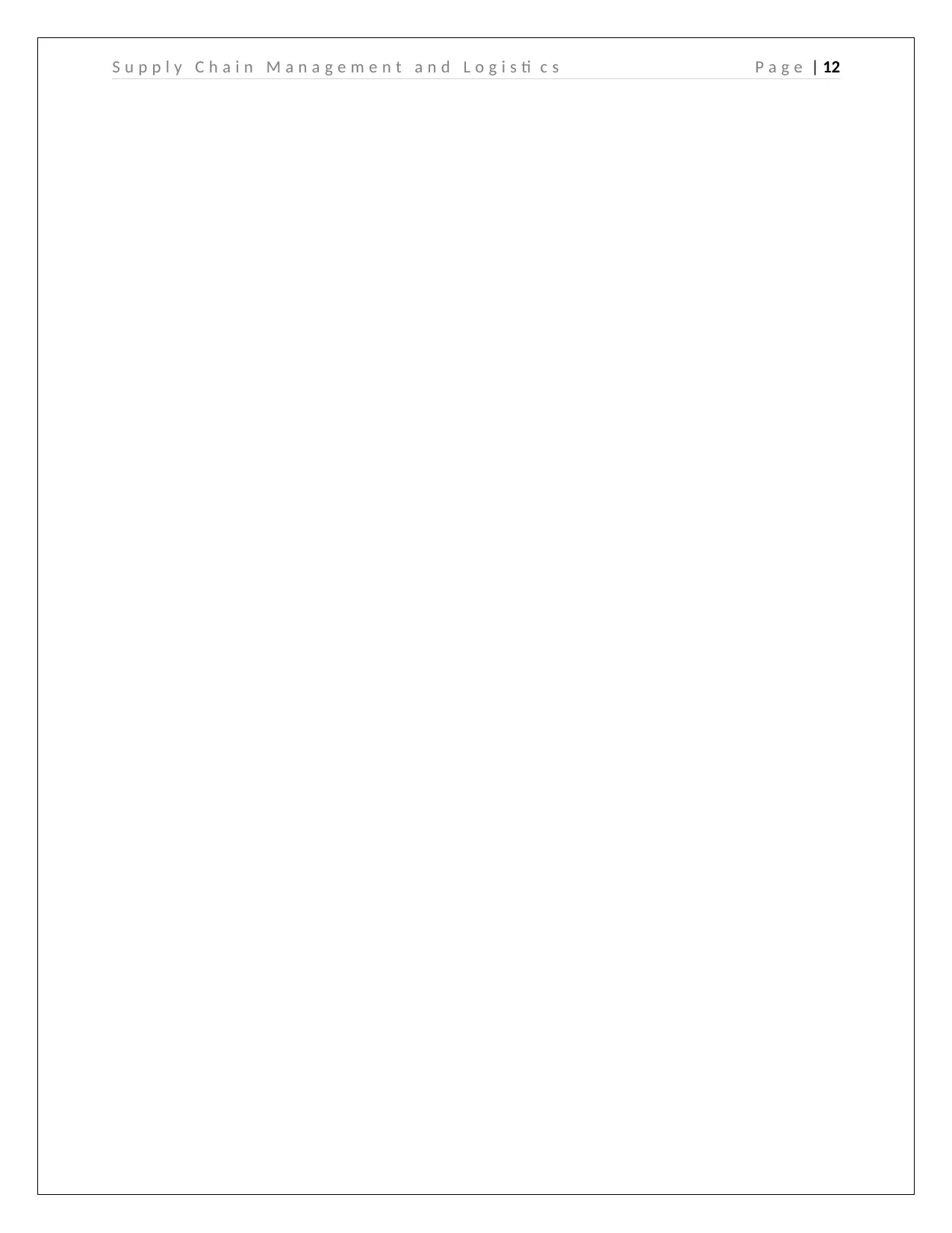
S u p p l y C h a i n M a n a g e m e n t a n d L o g i s ti c s P a g e | 12
Paraphrase This Document
Need a fresh take? Get an instant paraphrase of this document with our AI Paraphraser
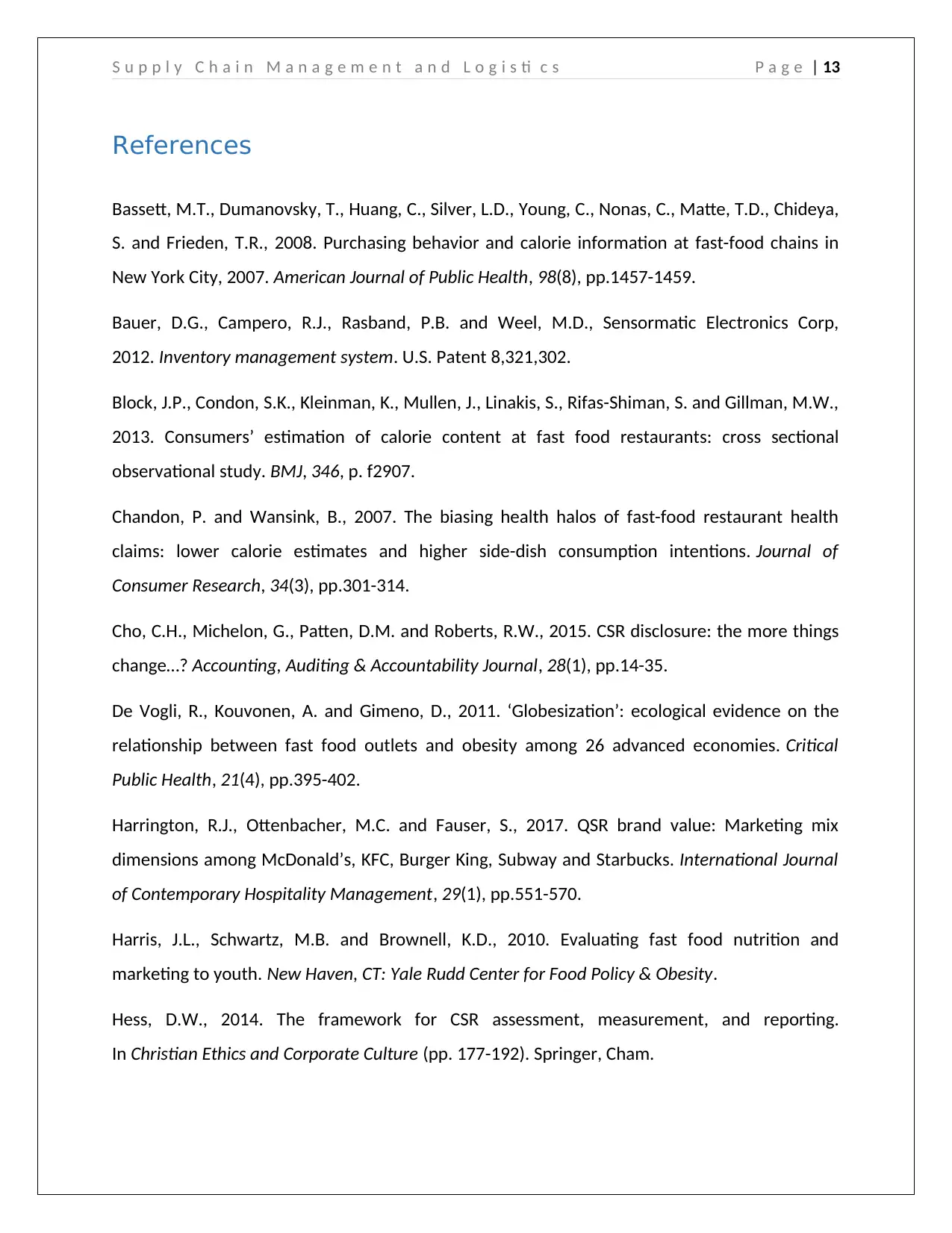
S u p p l y C h a i n M a n a g e m e n t a n d L o g i s ti c s P a g e | 13
References
Bassett, M.T., Dumanovsky, T., Huang, C., Silver, L.D., Young, C., Nonas, C., Matte, T.D., Chideya,
S. and Frieden, T.R., 2008. Purchasing behavior and calorie information at fast-food chains in
New York City, 2007. American Journal of Public Health, 98(8), pp.1457-1459.
Bauer, D.G., Campero, R.J., Rasband, P.B. and Weel, M.D., Sensormatic Electronics Corp,
2012. Inventory management system. U.S. Patent 8,321,302.
Block, J.P., Condon, S.K., Kleinman, K., Mullen, J., Linakis, S., Rifas-Shiman, S. and Gillman, M.W.,
2013. Consumers’ estimation of calorie content at fast food restaurants: cross sectional
observational study. BMJ, 346, p. f2907.
Chandon, P. and Wansink, B., 2007. The biasing health halos of fast-food restaurant health
claims: lower calorie estimates and higher side-dish consumption intentions. Journal of
Consumer Research, 34(3), pp.301-314.
Cho, C.H., Michelon, G., Patten, D.M. and Roberts, R.W., 2015. CSR disclosure: the more things
change…? Accounting, Auditing & Accountability Journal, 28(1), pp.14-35.
De Vogli, R., Kouvonen, A. and Gimeno, D., 2011. ‘Globesization’: ecological evidence on the
relationship between fast food outlets and obesity among 26 advanced economies. Critical
Public Health, 21(4), pp.395-402.
Harrington, R.J., Ottenbacher, M.C. and Fauser, S., 2017. QSR brand value: Marketing mix
dimensions among McDonald’s, KFC, Burger King, Subway and Starbucks. International Journal
of Contemporary Hospitality Management, 29(1), pp.551-570.
Harris, J.L., Schwartz, M.B. and Brownell, K.D., 2010. Evaluating fast food nutrition and
marketing to youth. New Haven, CT: Yale Rudd Center for Food Policy & Obesity.
Hess, D.W., 2014. The framework for CSR assessment, measurement, and reporting.
In Christian Ethics and Corporate Culture (pp. 177-192). Springer, Cham.
References
Bassett, M.T., Dumanovsky, T., Huang, C., Silver, L.D., Young, C., Nonas, C., Matte, T.D., Chideya,
S. and Frieden, T.R., 2008. Purchasing behavior and calorie information at fast-food chains in
New York City, 2007. American Journal of Public Health, 98(8), pp.1457-1459.
Bauer, D.G., Campero, R.J., Rasband, P.B. and Weel, M.D., Sensormatic Electronics Corp,
2012. Inventory management system. U.S. Patent 8,321,302.
Block, J.P., Condon, S.K., Kleinman, K., Mullen, J., Linakis, S., Rifas-Shiman, S. and Gillman, M.W.,
2013. Consumers’ estimation of calorie content at fast food restaurants: cross sectional
observational study. BMJ, 346, p. f2907.
Chandon, P. and Wansink, B., 2007. The biasing health halos of fast-food restaurant health
claims: lower calorie estimates and higher side-dish consumption intentions. Journal of
Consumer Research, 34(3), pp.301-314.
Cho, C.H., Michelon, G., Patten, D.M. and Roberts, R.W., 2015. CSR disclosure: the more things
change…? Accounting, Auditing & Accountability Journal, 28(1), pp.14-35.
De Vogli, R., Kouvonen, A. and Gimeno, D., 2011. ‘Globesization’: ecological evidence on the
relationship between fast food outlets and obesity among 26 advanced economies. Critical
Public Health, 21(4), pp.395-402.
Harrington, R.J., Ottenbacher, M.C. and Fauser, S., 2017. QSR brand value: Marketing mix
dimensions among McDonald’s, KFC, Burger King, Subway and Starbucks. International Journal
of Contemporary Hospitality Management, 29(1), pp.551-570.
Harris, J.L., Schwartz, M.B. and Brownell, K.D., 2010. Evaluating fast food nutrition and
marketing to youth. New Haven, CT: Yale Rudd Center for Food Policy & Obesity.
Hess, D.W., 2014. The framework for CSR assessment, measurement, and reporting.
In Christian Ethics and Corporate Culture (pp. 177-192). Springer, Cham.
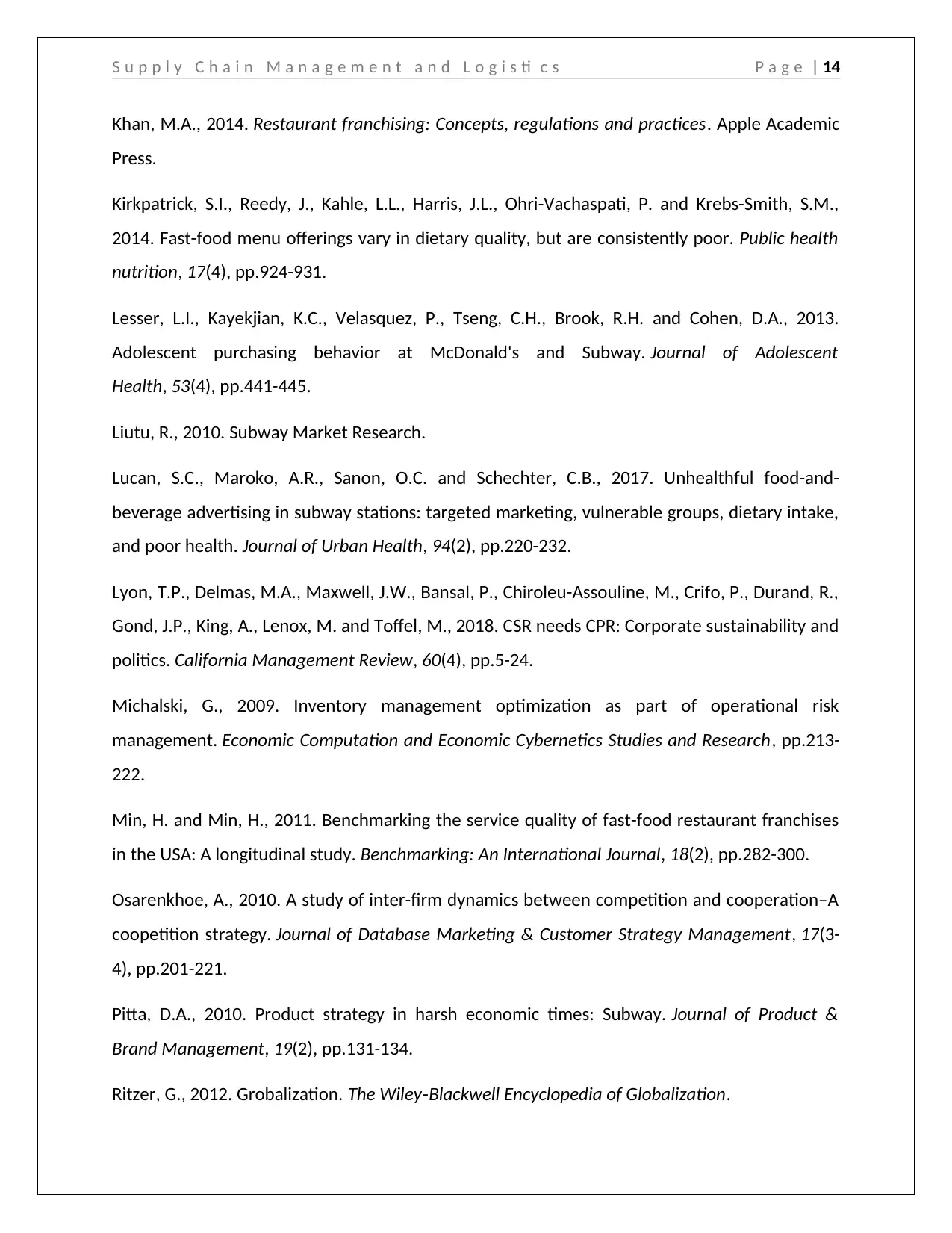
S u p p l y C h a i n M a n a g e m e n t a n d L o g i s ti c s P a g e | 14
Khan, M.A., 2014. Restaurant franchising: Concepts, regulations and practices. Apple Academic
Press.
Kirkpatrick, S.I., Reedy, J., Kahle, L.L., Harris, J.L., Ohri-Vachaspati, P. and Krebs-Smith, S.M.,
2014. Fast-food menu offerings vary in dietary quality, but are consistently poor. Public health
nutrition, 17(4), pp.924-931.
Lesser, L.I., Kayekjian, K.C., Velasquez, P., Tseng, C.H., Brook, R.H. and Cohen, D.A., 2013.
Adolescent purchasing behavior at McDonald's and Subway. Journal of Adolescent
Health, 53(4), pp.441-445.
Liutu, R., 2010. Subway Market Research.
Lucan, S.C., Maroko, A.R., Sanon, O.C. and Schechter, C.B., 2017. Unhealthful food-and-
beverage advertising in subway stations: targeted marketing, vulnerable groups, dietary intake,
and poor health. Journal of Urban Health, 94(2), pp.220-232.
Lyon, T.P., Delmas, M.A., Maxwell, J.W., Bansal, P., Chiroleu-Assouline, M., Crifo, P., Durand, R.,
Gond, J.P., King, A., Lenox, M. and Toffel, M., 2018. CSR needs CPR: Corporate sustainability and
politics. California Management Review, 60(4), pp.5-24.
Michalski, G., 2009. Inventory management optimization as part of operational risk
management. Economic Computation and Economic Cybernetics Studies and Research, pp.213-
222.
Min, H. and Min, H., 2011. Benchmarking the service quality of fast-food restaurant franchises
in the USA: A longitudinal study. Benchmarking: An International Journal, 18(2), pp.282-300.
Osarenkhoe, A., 2010. A study of inter-firm dynamics between competition and cooperation–A
coopetition strategy. Journal of Database Marketing & Customer Strategy Management, 17(3-
4), pp.201-221.
Pitta, D.A., 2010. Product strategy in harsh economic times: Subway. Journal of Product &
Brand Management, 19(2), pp.131-134.
Ritzer, G., 2012. Grobalization. The Wiley‐Blackwell Encyclopedia of Globalization.
Khan, M.A., 2014. Restaurant franchising: Concepts, regulations and practices. Apple Academic
Press.
Kirkpatrick, S.I., Reedy, J., Kahle, L.L., Harris, J.L., Ohri-Vachaspati, P. and Krebs-Smith, S.M.,
2014. Fast-food menu offerings vary in dietary quality, but are consistently poor. Public health
nutrition, 17(4), pp.924-931.
Lesser, L.I., Kayekjian, K.C., Velasquez, P., Tseng, C.H., Brook, R.H. and Cohen, D.A., 2013.
Adolescent purchasing behavior at McDonald's and Subway. Journal of Adolescent
Health, 53(4), pp.441-445.
Liutu, R., 2010. Subway Market Research.
Lucan, S.C., Maroko, A.R., Sanon, O.C. and Schechter, C.B., 2017. Unhealthful food-and-
beverage advertising in subway stations: targeted marketing, vulnerable groups, dietary intake,
and poor health. Journal of Urban Health, 94(2), pp.220-232.
Lyon, T.P., Delmas, M.A., Maxwell, J.W., Bansal, P., Chiroleu-Assouline, M., Crifo, P., Durand, R.,
Gond, J.P., King, A., Lenox, M. and Toffel, M., 2018. CSR needs CPR: Corporate sustainability and
politics. California Management Review, 60(4), pp.5-24.
Michalski, G., 2009. Inventory management optimization as part of operational risk
management. Economic Computation and Economic Cybernetics Studies and Research, pp.213-
222.
Min, H. and Min, H., 2011. Benchmarking the service quality of fast-food restaurant franchises
in the USA: A longitudinal study. Benchmarking: An International Journal, 18(2), pp.282-300.
Osarenkhoe, A., 2010. A study of inter-firm dynamics between competition and cooperation–A
coopetition strategy. Journal of Database Marketing & Customer Strategy Management, 17(3-
4), pp.201-221.
Pitta, D.A., 2010. Product strategy in harsh economic times: Subway. Journal of Product &
Brand Management, 19(2), pp.131-134.
Ritzer, G., 2012. Grobalization. The Wiley‐Blackwell Encyclopedia of Globalization.
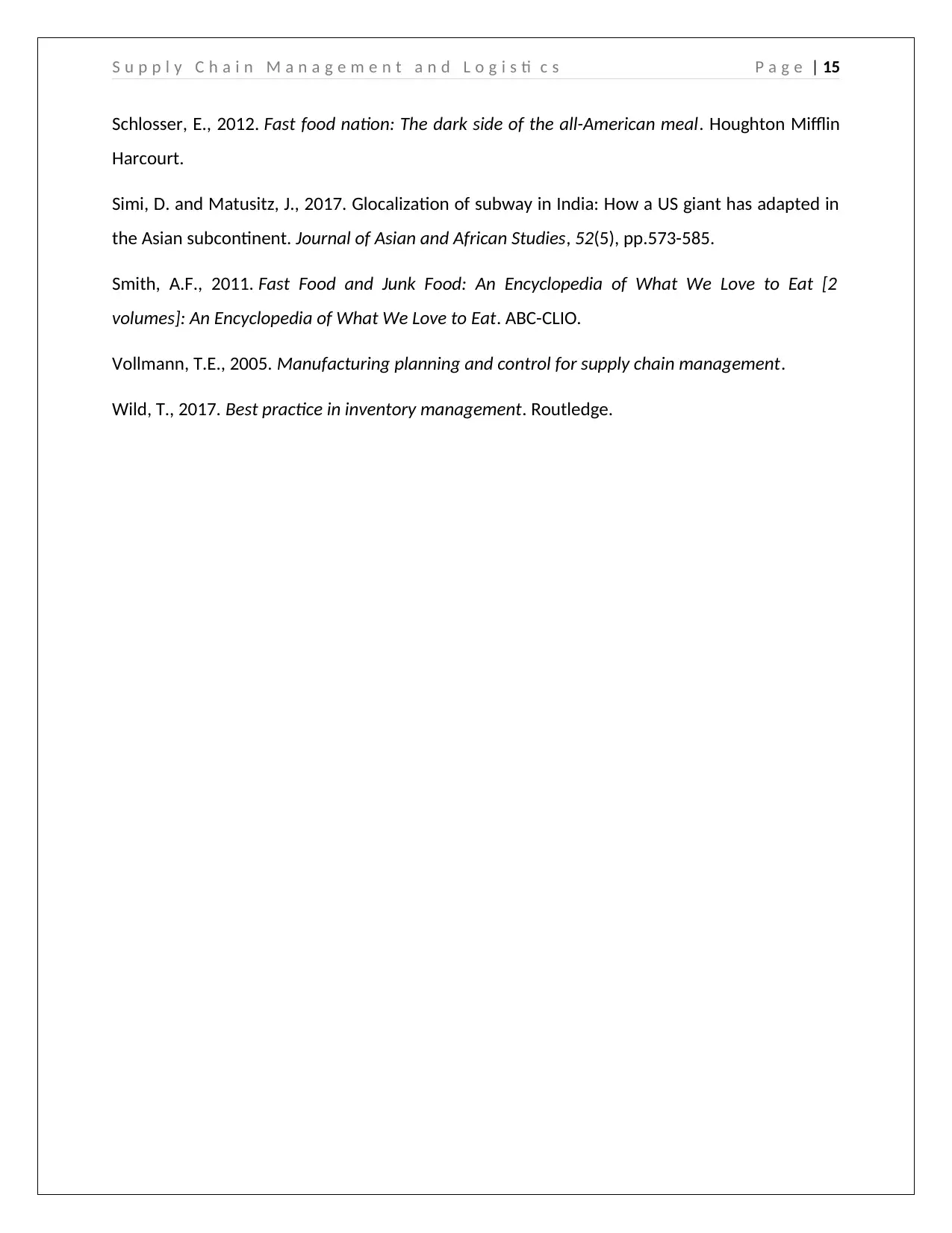
S u p p l y C h a i n M a n a g e m e n t a n d L o g i s ti c s P a g e | 15
Schlosser, E., 2012. Fast food nation: The dark side of the all-American meal. Houghton Mifflin
Harcourt.
Simi, D. and Matusitz, J., 2017. Glocalization of subway in India: How a US giant has adapted in
the Asian subcontinent. Journal of Asian and African Studies, 52(5), pp.573-585.
Smith, A.F., 2011. Fast Food and Junk Food: An Encyclopedia of What We Love to Eat [2
volumes]: An Encyclopedia of What We Love to Eat. ABC-CLIO.
Vollmann, T.E., 2005. Manufacturing planning and control for supply chain management.
Wild, T., 2017. Best practice in inventory management. Routledge.
Schlosser, E., 2012. Fast food nation: The dark side of the all-American meal. Houghton Mifflin
Harcourt.
Simi, D. and Matusitz, J., 2017. Glocalization of subway in India: How a US giant has adapted in
the Asian subcontinent. Journal of Asian and African Studies, 52(5), pp.573-585.
Smith, A.F., 2011. Fast Food and Junk Food: An Encyclopedia of What We Love to Eat [2
volumes]: An Encyclopedia of What We Love to Eat. ABC-CLIO.
Vollmann, T.E., 2005. Manufacturing planning and control for supply chain management.
Wild, T., 2017. Best practice in inventory management. Routledge.
1 out of 16
Related Documents
Your All-in-One AI-Powered Toolkit for Academic Success.
+13062052269
info@desklib.com
Available 24*7 on WhatsApp / Email
![[object Object]](/_next/static/media/star-bottom.7253800d.svg)
Unlock your academic potential
© 2024 | Zucol Services PVT LTD | All rights reserved.





